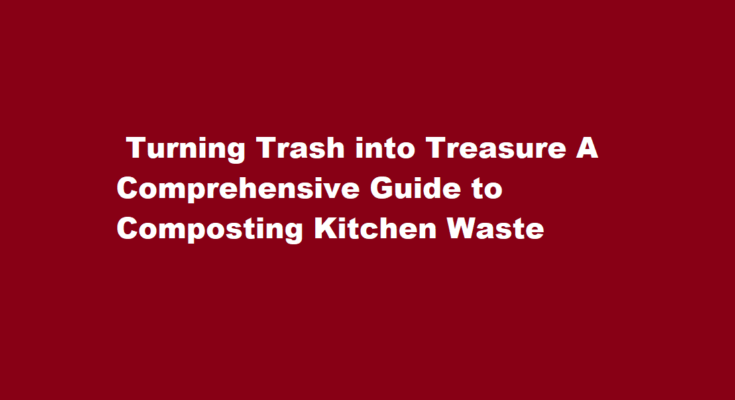Introduction
In an era where environmental consciousness is paramount, finding sustainable solutions to reduce waste and nourish our planet has never been more crucial. Composting kitchen waste is a simple yet powerful way to minimize your ecological footprint while transforming organic scraps into nutrient-rich soil. This article will provide you with a comprehensive guide on how to compost kitchen waste effectively, ensuring that you contribute positively to the environment and create fertile soil for your garden.
Understanding the Basics
Before you start composting kitchen waste, it’s essential to understand the basics of composting. Compost is the result of the natural decomposition of organic materials like kitchen scraps, yard waste, and leaves. The process involves the breakdown of these materials by microorganisms, eventually turning them into a nutrient-rich humus that can be used to improve soil quality.
What Can and Can’t Be Composted
Not all kitchen waste is suitable for composting. While organic materials like fruit and vegetable scraps, coffee grounds, and eggshells are ideal, avoid composting meat, dairy, and oily foods, as they can attract pests and slow down the composting process. Additionally, steer clear of items like plastics, glass, and metals, which don’t decompose and can contaminate your compost pile.
Setting Up Your Composting System
To get started with composting kitchen waste, you’ll need a few essential items
1. Compost bin or pile: You can choose from various options, including indoor bins, outdoor piles, or even specialized compost tumblers.
2. Browns and greens: Browns, such as dry leaves, straw, and newspaper, provide carbon, while greens like kitchen scraps offer nitrogen. A proper balance of these materials is essential for successful composting.
3. Aeration: Regularly turn or aerate your compost pile to provide oxygen to the microorganisms responsible for decomposition.
4. Moisture: Keep your compost pile moist, like a wrung-out sponge, to support the decomposition process.
Layering and Maintaining Your Compost
Layering your compost pile is crucial for efficient decomposition. Begin with a layer of browns, followed by a layer of greens, and repeat. Ensure that you maintain a balance between these layers as you add new kitchen waste over time. Regularly turn the pile to aerate it, which will help prevent unpleasant odors and accelerate decomposition. Water the pile as needed to maintain the right moisture level.
Troubleshooting Common Issues
Composting kitchen waste may encounter a few hiccups along the way. If your compost pile smells bad, it might be too wet or have an excess of greens. Add more browns and aerate to rectify the issue. If your compost isn’t heating up, it might need more nitrogen-rich materials. Adjust your green-to-brown ratio accordingly. Pests can be deterred by burying kitchen scraps deep within the pile or using a pest-resistant bin.
Harvesting Your Compost
Composting is a patient process, but your efforts will be rewarded. After several months to a year, depending on the conditions and methods, your compost will be ready. It should resemble dark, crumbly soil. Remove any undecomposed materials, and your nutrient-rich compost is ready for use in your garden.
Frequently Asked Questions
What type of kitchen waste is used for preparing compost?
Fruits and vegetable peels, non-greasy food and egg shells are the kitchen wastes which can be used for preparing the compost.
How long does kitchen compost take?
Decomposition will be complete anywhere from two weeks to two years depending on the materials used, the size of the pile, and how often it is turned.
Conclusion
Composting kitchen waste is a sustainable practice that anyone can adopt. By diverting organic waste from landfills, you reduce greenhouse gas emissions and produce valuable compost that enriches soil and promotes plant growth. Start small, follow these guidelines, and witness the positive impact you can make on the environment, one kitchen scrap at a time.
Read Also : Reviving Faded Clothes A Natural Approach to Dyeing



